College of Dreams: Creating a Bright Future for ALL Students
Where Princeton Nelson came from, a college education wasn’t just at the outer edges of possibility, it was beyond imagination. Yet here he was, a proud member of the class of 2018 at Georgia State University, a computer science major with a cap and gown and a more than respectable 3.3 GPA, taking his place at a crowded indoor commencement ceremony along with the Atlanta Fife Band and professors in gowns of many colors and a cascade of balloons in Panther blue and white that tumbled from the ceiling like confetti.
He, too, got to shake hands with the university president, Mark Becker, whose welcoming remarks had invoked “the magical power of thinking big.” He, too, got to hug his fellow graduates, many of them seven or eight years younger than him. He, too, could bask in the pride of his relatives, none more amazed or delighted than the grandmother who had thrown him out as a teenager because he’d been too unruly to handle.
Princeton Nelson came from nothing, and he understood at an early age that it would be up to him to carve a path to something better.
Nelson came from nothing, and he understood at an early age that it would be up to him to carve a path to something better, because nobody else was going to do it for him. Even when he slipped — and he slipped a lot — he knew the choices he made could mean the difference between life and death. He was born in an Iowa prison, the child of two parents convicted of drug dealing at the height of the crack cocaine epidemic.
Mostly, he was raised by his grandmother, Loretta, who did her best to raise Nelson and three siblings on an assembly worker’s salary in a small red house in suburban Chicago. Nelson’s mother was in no state to take him even when she got out of prison. She fell back into the drug underworld and, months after her release, was found shot to death in an abandoned building on Chicago’s South Side.
Loretta moved Princeton and his siblings to Atlanta for a fresh start, but there was little she could do to make up for what he had lost — or never had. By sixth grade, he was attending an institution for children with severe emotional and behavioral problems. His grades yo-yoed, he bounced in and out of special schools, and he barely graduated from high school.
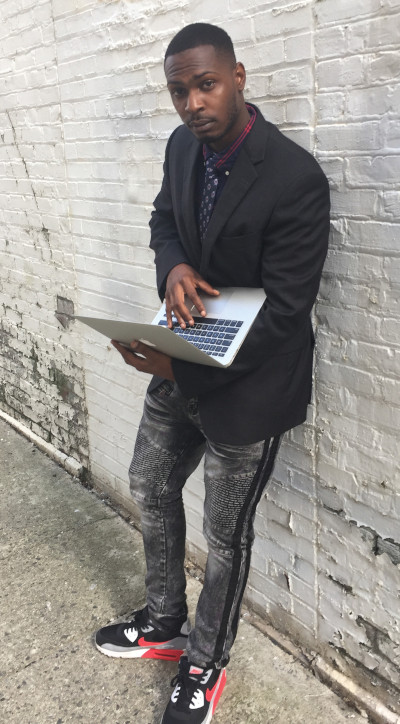
Turning himself around was a long and painful process. For years, he worked in warehouses and smoked weed and gave little thought to where his life was going. Still, he hated the feeling that he was a disappointment to his grandmother. He signed himself up at Atlanta Technical College, thinking at first that he’d train to be a barber. Then it dawned on him that as long as he was taking out loans he’d be better off working toward an academic degree, not just a trade qualification. As it happened, there was a community college, Atlanta Metropolitan, right across the street, and he wandered over one day to enroll as a music major. He’d always enjoyed creating music beats on his grandmother’s computer. Why not see where it could take him?
As he stood in line to register, he noticed a chart listing the professional fields expected to be most in demand in the Atlanta area by 2020, and his eyes fell on the words “computer science.” “What did I have next to me in my grandmother’s house this whole time?” he said. “A computer!” It wasn’t just music beats that he’d created. He’d also worked on MySpace pages and video games, never thinking there could be a future in it. But now, apparently, there was. “It was a flash of light,” he said, “I’m thinking, I’m a computer science major. That’s my calling.”
Nelson’s grades were strong enough to earn him an associate’s degree in computer science in two years. But his life, like that of almost every lower-income college student, remained precarious at best, a constant battle for time and money. When his aunt and uncle bought the house where he and his grandmother were living, one of the first things they did was evict him, saying they were concerned about his pot use and the shortcuts they suspected he was taking to make ends meet. Before he could think of pursuing his studies further, he had to deal with the realities of homelessness. For two weeks he slept on the concrete floor of a bus station so he could bump up his savings from a job flipping burgers and buy himself a car. Once he had his Volkswagen Jetta, he signed on as an Uber driver. Soon he had a third job, as a security guard. Three days a week he stayed in a hotel to enjoy a bed and a hot shower; the other four days he parked overnight at a 24-hour gas station or outside a Kroger’s supermarket where the lights and security cameras made it less likely he’d be robbed, or worse.
He was still homeless when he started at Georgia State in the fall of 2016, but starting in his second year, he joined forces with two of his fellow computer science majors and started designing websites as a side gig. That made him hopeful enough to move out of his car and put all his savings into a deposit for an apartment. It was touch and go at first, because the freelance design work didn’t come in as quickly as hoped, and he had to take a full-time job as a cellphone technician for two weeks to make what he needed for the next month’s rent.
To many eyes, Nelson might not have looked like college material at all. Georgia State, though, was starting to enjoy a national reputation for its pioneering work in retaining and graduating large numbers of students much like him — poor, Black, and struggling to make it as the first in their family to attend college. The university understood his need for extra support. When it became apparent he was depressed because of the financial pressures, he was encouraged to see a campus therapist, the first counselor he’d ever talked to. Twice when his money was running dangerously low, the university awarded him grants to help him reach the finish line.
Academics were never Nelson’s problem. Next to what he’d been through, a challenging course in math or programming held no terrors. Rather, he became fascinated by what it meant to live a normal, middle-class life and was determined to learn how to lead one himself. “I’m always thinking about where I came from. And I still feel like I’m dumb, like I’m still competing with all these college students and falling short.”
While the children of the rich and the very rich continue to enjoy expanding opportunities to pursue a university education, the prospects for everyone else have either stagnated or narrowed dramatically.
It’s a feeling that did not go away even after he graduated and headed toward his first full-time job as a software engineer for Infosys. “That’s the difference between me and those Harvard kids,” he said. “If people like me fail, we’re going to fail our life.”
Nelson was far from the only member of Georgia State’s class of 2018 with a tale of adversity and triumph. Greyson Walldorff, who had been forced to give up an athletic scholarship in his sophomore year because of a concussion, stayed afloat and completed a business degree by starting a landscaping company that grew over time to five employees and more than a hundred clients. Larry Felton Johnson completed a journalism degree on his fourth try, 49 years after he first enrolled, thanks to a state program that offered free tuition to students over the age of 62.
Then there was Savannah Torrance, who had almost dropped out in her freshman year because she was commuting 60 miles each way from her mother’s house, working long shifts at a supermarket, and absolutely hating the chemistry class she thought she needed to build a career in the medical field. Thanks to some timely guidance from Georgia State’s advising center, though, she switched to speech communications, which required no chemistry, won a state merit scholarship she’d narrowly missed out of high school, and was soon thriving both in her studies and as a student orientation leader, university ambassador, and member of the student government association.
Georgia State boasts almost no success story that doesn’t include at least one moment where everything was in danger of crumbling to dust. At a school where close to 60 percent of undergraduates are poor enough to qualify for the federal Pell grant, that is just the nature of things. What is remarkable about Georgia State students is that despite the precariousness of many of their lives, they still graduate in extraordinary numbers. In 2018, more than 7,000 crossed the commencement stage, 5,000 of them to pick up a bachelor’s degree and the rest an associate’s degree from one of the university’s five community college campuses scattered around the Atlanta suburbs. That translated to a six-year graduation rate of close to 60 percent, significantly above the national average.
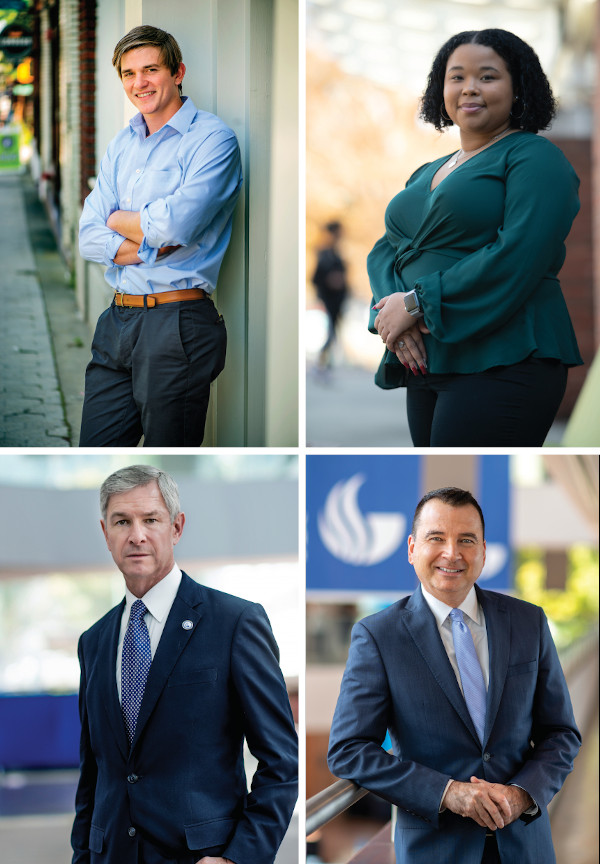
Georgia State’s achieved a 74 percent increase in the graduation rate over 15 years. This is not just about the lives of a few unusually tenacious and talented individuals. We are talking about a fundamental transformation, a real-time experiment in social mobility that the university has learned to perform consistently, and at scale.
How did Georgia State do it? In the wake of the 2008 recession, a new leadership team at Georgia State, acting out of economic necessity as well as moral conviction, determined that there was nothing inevitable about the failure of students who were poor, or nonwhite, or whose parents had never attended college. Rather, what held them back were barriers erected by the university itself and by the broader academic culture. Georgia State developed data to understand those barriers and to identify the inflection points where students most commonly came to a crossroads between success and failure. For years, Georgia State has graduated more African Americans than any other university in the country — not by tailoring special programs to them but by treating them like everyone else and providing support where they need it, regardless of wealth, or skin color, or any other consideration.
While the children of the rich and the very rich continue to enjoy expanding opportunities to pursue a university education, the prospects for everyone else have either stagnated or narrowed dramatically.
Once, student success was thought to be a simple combination of academic promise and hard work. Now even the pretense of that egalitarianism is gone; it’s all about money and whether your parents went to college. A study by the National Center for Education Statistics from 2000 — when things were better than they have become — found that a student in the top income quartile with at least one college-educated parent had a 68 percent chance of graduating before the age of 26, whereas a student in the bottom quartile whose parents did not go to college had a 9 percent chance.
It’s not that these staggering problems have gone unnoticed. Mostly, institutions have been at a loss to address them. Many prefer to keep their focus elsewhere — on graduate programs, on research, or on cultivating an elite class of undergraduates from that golden upper quartile. Some like to point fingers: at the shortcomings of the K–12 education system, at budget-cutting state legislatures, at a political culture that loves to hate academia and questions why students don’t invest in their own futures instead of relying on the public purse for financial aid. It has become fashionable for elite institutions to brag about the lower-income students they champion and finance, but they do this at a scale entirely dwarfed by a public university like Georgia State, which has three times as many Pell-eligible students as the entire Ivy League.
It has taken more than 20 years to come up with a more durable answer to the problem and to push back against a higher education culture that too often serves the interests of everyone but the students. The first stirrings came at a handful of public universities in Florida, Georgia, Tennessee, and Arizona — states with rapidly growing urban populations and a hunger for economic growth that exceeded any appetite to hold back historically suppressed racial minorities. Why, administrators in these states started asking, should faculty members get to decide when to teach classes if it means students have to wait extra semesters to take courses essential to their majors? Why should students with no family history of negotiating an undergraduate degree have to figure out for themselves which classes to take, in which order?
Starting in the mid-1990s, these campuses rewrote course maps, rethought student advising, grouped freshmen together by subject area, lifted registration holds for petty library fines, and found a variety of other ways to ease the students’ path through the campus bureaucracy.
After 2008, Georgia State was able to take these ideas and turbocharge them with the analytical powers of emerging new data technologies. The incoming president, Mark Becker, was a statistician by training who understood the power of creating successful models and scaling them across tens of thousands of students. His student success guru, Tim Renick, had been a singularly gifted classroom teacher and needed no persuading that lower-income and first-generation students were worth believing in, because he’d seen over and over how they responded to his teaching and thrived.
Renick couldn’t stomach a system that knowingly sold students a bill of goods, inducing them to load themselves up with debt for a degree that at least half of them stood no chance of getting. What started as a moral imperative to graduate large numbers of traditionally underserved students has become a national rallying cry, a challenge to other institutions to ditch the old excuses and follow Georgia State’s lead.
The wonder of Georgia State rests on a simple idea: that if students are good enough to be admitted, they deserve an environment in which they can nurture their talents regardless of personal circumstances.
Georgia State’s pioneering innovations have been written up in The New York Times and discussed with fervor at hundreds of education conferences. Public universities nationally are in broad agreement that the revolution in downtown Atlanta points the way to all their futures. These breakthroughs came about thanks to the interactions of those educators who threw themselves into the work and stuck with it despite long hours and modest compensation, because they couldn’t imagine doing anything more meaningful with their lives; and of course the role played by the students, whose tenacious example and unbreakable will either inspired important changes or exemplified their life-changing benefits or, often, a bit of both.
Andrew Gumbel worked as a foreign correspondent for Reuters and the British newspapers The Guardian and The Independent. He is the author of Down for the Count, Oklahoma City, and Won’t Lose This Dream.
Copyright © 2020 by Andrew Gumbel. This excerpt originally appeared in Won’t Lose This Dream: How an Upstart Urban University Rewrote the Rules of a Broken System, published by The New Press. Reprinted here with permission.
This article is featured in the November/December 2020 issue of The Saturday Evening Post. Subscribe to the magazine for more art, inspiring stories, fiction, humor, and features from our archives.
Featured image: The future looks bright: GSU has gained a reputation for graduating large numbers of students who are poor, Black, and struggling. (Steve Thackston/staff photographer at Georgia State University)
Considering History: The Real Crisis Facing Public Higher Education in America
This series by American studies professor Ben Railton explores the connections between America’s past and present.
On March 22, President Trump issued an Executive Order that affects one of America’s most significant, shared spaces and communities: our institutions of higher education. Entitled “Improving Free Inquiry, Transparency, and Accountability at Colleges and Universities,” the EO threatens to remove federal funding from institutions of higher education that do not “promote free inquiry” on their campuses. Although the EO itself does not spell out the meaning of that phrase further, it has been celebrated by conservative groups such as Turning Point USA, who believe the EO to be an endorsement of their critiques of universities where far-right speakers have been either disinvited from speaking or protested when they did speak.
There isn’t a free speech crisis on America’s college campuses, nor is this striking Executive Order genuinely seeking to address such an issue. Yet this moment nonetheless offers us an opportunity to consider a legitimate crisis facing public higher education in America: The abandonment of funding of these institutions. This issue threatens the founding and enduring mission and role of these schools in our society.
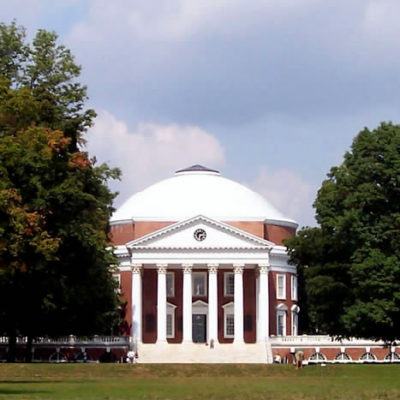
America’s first public universities were created as overt alternatives to the Revolutionary era’s elite, religious private colleges such as Harvard and Yale. Thomas Jefferson’s University of Virginia, for example, represented the nation’s first non-sectarian university, one intended to have no affiliation with or sponsorship from a religious faith. The other earliest public universities, such as the University of Georgia (founded in 1785) and the University of North Carolina (founded in 1795), were likewise intended to open up higher education to students beyond the wealthy planter elites in these states. While certainly their target audiences remained white male students, they nonetheless represented first steps in the democratization of American higher education.
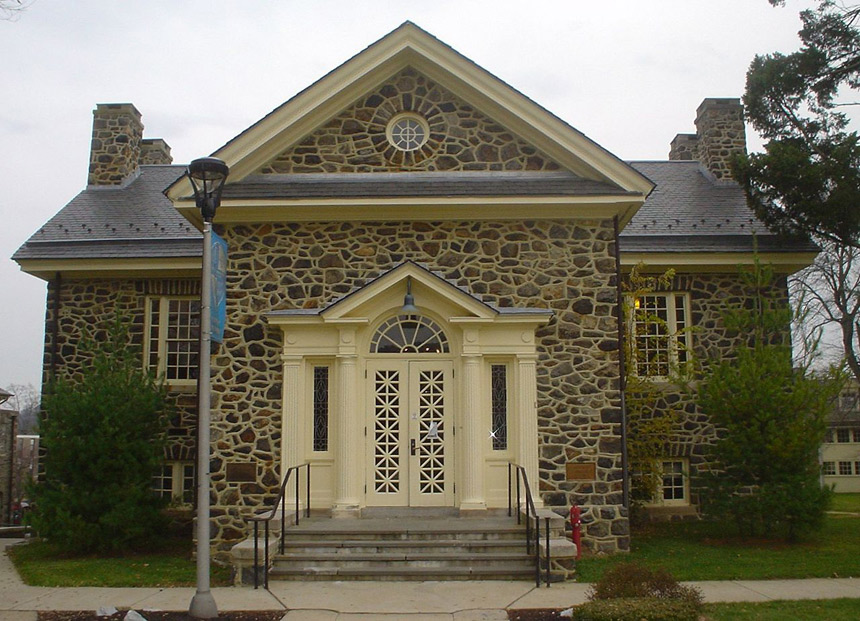
Over the course of the 19th century, that democratizing promise was gradually extended to additional American communities. The creation of the institutions that have become known as Historically Black Colleges & Universities (HBCUs), a process that began with the 1837 founding of Cheyney University of Pennsylvania, made higher education available to African American students for the first time. Many of the earliest women’s colleges in America were private institutions, but in 1884 the Mississippi state legislature established the public women’s Industrial Institute & College (later Mississippi University for Women), and over the next two decades Georgia (1889), North Carolina (1891), and Florida (1905) founded their own public women’s colleges as well.
The 19th century also saw the founding across the country of a number of public teaching academies, generally known as Normal Schools, that likewise included (if they were not indeed initially limited to) female students and paved the way for another evolving system of public colleges and universities that endures to this day. The history of the institution where I teach, Fitchburg State University in Massachusetts, illustrates that legacy: the State Normal School in Fitchburg was initially founded in 1894, added a Bachelor’s degree in “practical” arts in 1930, changed its name to the State Teachers College at Fitchburg in 1932, and then became Fitchburg State College in 1965 (and Fitchburg State University in 2010).
Yet FSU’s 21st century situation also reflects the central challenge and crisis facing public higher education in Massachusetts and around the country. Over the last two decades or so Massachusetts has largely disinvested in public higher education. Between 2001 and 2018 the amount Massachusetts spends per resident student in our public universities has decreased by 31%. According to the Center on Budget and Policy Priorities, of the 49 states analyzed over the full 2008-2018 period, after adjusting for inflation, 45 spent less per student in the 2018 school year than in 2008.
While this decline in funding affects every aspect of public higher education, it has hit students particularly hard: According to the National Center for Education Statistics, prices for undergraduate tuition, fees, room, and board at public institutions rose 34 percent between 2006 and 2016 (adjusting for inflation). Total student loan debt is $1.52 trillion, a 302 percent increase since 2004.
Each of these trends is linked to and influenced by a number of factors, but the overall trends are all too clear: legislators and politicians have increasingly chosen not to fund public higher education in the 21st century; and the costs have been passed on to the institutions and, especially, their students. While that trend has been perhaps particularly pronounced in Massachusetts (which now ranks 34th in the nation in per resident student state spending), it has at the same time been taking place throughout the nation (and of course is paralleled by similar disinvestments in public secondary and primary education). If these trends continue, public higher education might soon become something it has not been since its earliest iterations (if ever): a community that only the wealthiest and most privileged Americans can afford to join.
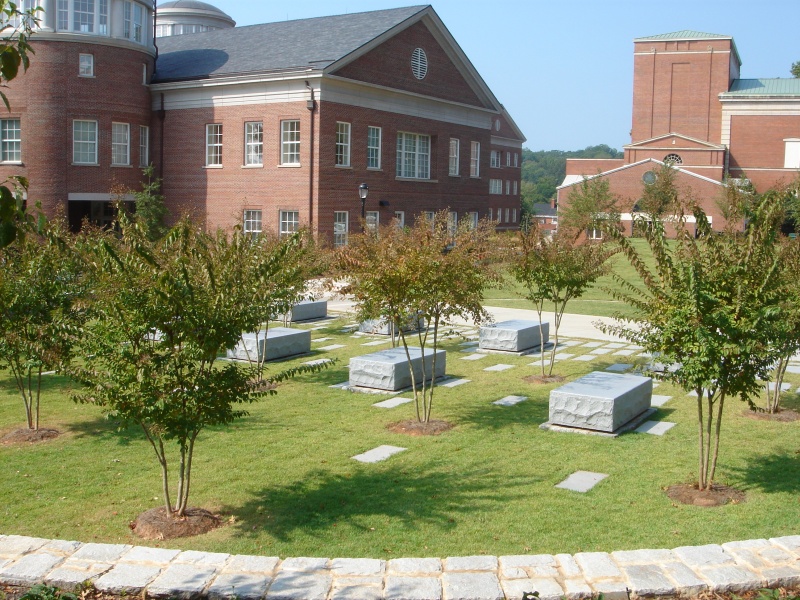
Here in Massachusetts, two proposed state laws seek to counter these trends and begin to chart a new way: the Promise and Cherish Acts, which would offer significant funding shifts and increases for public primary, secondary, and higher education over the next five years (among many other features). This past Tuesday, Fitchburg State hosted one of the numerous Fund Our Future forums taking place throughout the state, to highlight these crises and the proposed bills, and to feature the voices of students, faculty and staff, and community members testifying to both the challenges they face and the value of public higher education. What I saw and heard there was the best of what public higher education has meant in America and can mean in the 21st century, if we live up to our legacies, reverse our current trends, and recognize the true crisis facing American higher education.
What’s the Matter with College?
You won’t get many people interested in discussing “the problems of higher education” until you bring up the trillion dollars. That’s the amount that America’s students now owe on their college tuition.
It’s hard to comprehend how much money $1,000,000,000,000 is. Consider this: It’s more than twice the amount, adjusted for inflation, that America paid to build its vast interstate highway system.
That’s a lot of money to repay. And with today’s sluggish economy and unemployment, more than one economist is losing sleep over whether we’ll ever clear that debt.
It’s no surprise that higher education is starting to draw the same amount of media attention, and criticism, as other big businesses. Critics are now challenging college’s admission policies, the merit of high-prestige universities, the need for traditional college lecture, and, of course, the cost.
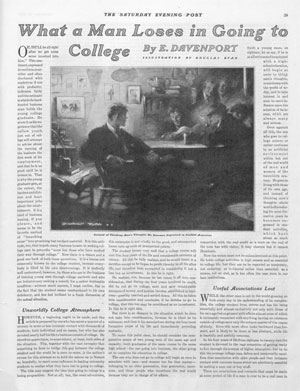
Criticizing higher education is nothing new. Back in 1920, a Post article entitled “What a Man Loses in Going to College,” questioned whether higher education wasn’t a handicap to young men and women. “The average college man [loses] association with older people and that intimate contact with concrete issues which are absolutely essential in making a man out of boy stuff,” wrote E. Davenport.
“Instead of thinking men’s thoughts about a world during his most formative years, [the student] becomes engrossed in student activities, which have about as much connection with the real world as a wart on the end of the nose has with vision; it may obscure but it cannot illuminate.”
The author also claimed that young men, after spending four years among a juvenile cohort, became apathetic, vain, egotistical, argumentative, unreliable, and addicted to slang.
The Post editors also held a low opinion of college training. In a 1923 editorial, editors argued that a four-year degree could be earned in half the time if only students were taught a capacity for drudgery and self-discipline. Instead, colleges bred effete snobs. “We see thousands of young men turned out of college who have never learned how to work, who would scorn to yield to the obligation to do any kind of manual labor other than golf or tennis.”
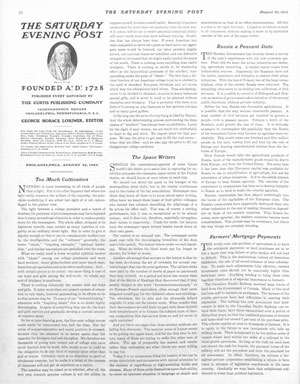
By 1927, Albert W. Atwood claimed colleges were lowering their standards to admit mediocre and marginally intelligent scholars. He quoted criticism from the Association of University Professors, which sounds as if it could be written today: “When a university numbers its students by the thousands and the tens of thousands, when it admits almost anybody and teaches almost anything, when its classrooms are manned, as is inevitable, by inferior teachers, whenever endowment or appropriation must be sought in a vain effort to keep pace with its numerical growth, when each tries to outstrip its rivals in the externals and trappings of education, then the very character of the university is bound to change for the worse.”
In 1938, Dr. Robert M. Hutchins, the University of Chicago’s president, added his criticism. In “Why Go to College?” he admitted that higher education was often used as a dumping ground for young people. It was where some parent sent their children to get them out of the house for four years, and where young men and women went to avoid adulthood and responsibility.
Twenty years later, a journalism professor at the University of Indiana claimed colleges had become little more than marriage mills and fun factories. In “Are We Making a Playground Out of College?” Jerome Ellison wrote that colleges had developed a “Second Curriculum is that odd mixture of status hunger, voodoo, tradition, lust, stereotyped dissipation, love, solid achievement, and plain good fun sometimes called ‘college life.’ It drives a high proportion of our students through college chronically short of sleep, behind in their work, and uncertain of the exact score in any department of life.”
In 1965, Dr. Hutchins returned to the Post, this time declaring “Colleges Are Obsolete.” Higher education, he wrote, had become an industry concerned with numbers, not values. Colleges were only concerned with helping students amass the right number of semester hours for graduation. They couldn’t help students become more intelligent because they were no longer intellectual communities “thinking together about important things.” Instead, the campus had become just a collection of isolated specialties. “The student is never compelled to put together what the specialists have told him, because he is examined course by course by the teacher who taught the course.”
Hutchins’ article touches on the ultimate question of college: “Do our colleges help their students become more intelligent? The answer is, on the whole, no.”
Americans expect a college education to do something important, valuable, and lasting for a student. It’s difficult to assess whether a student is more intelligent after graduation. Let’s consider the value of college by a more practical measure: How much more can a graduate earn?
By this standard, college is still doing its job. Recent labor statistics from 2013 show that average Americans earned almost twice as much per hour if they had a four-year degree.
However, every college student must still individually solve the following problem: Does this earning advantage, extended over a 20-year career exceed the investment of four years and a pre-interest cash value of $18,000 to $46,000?